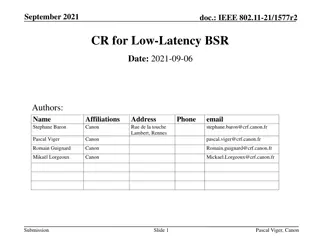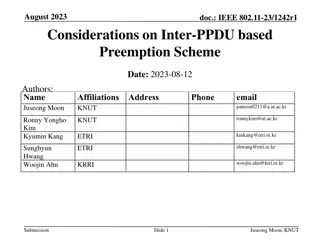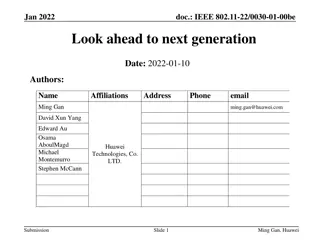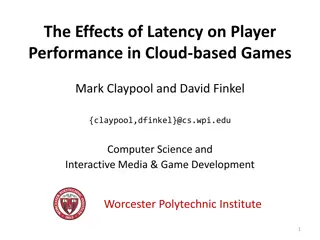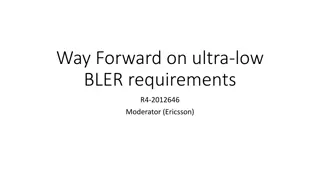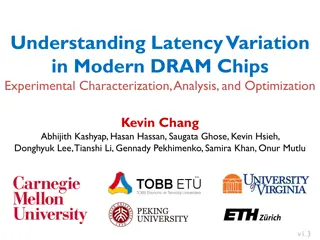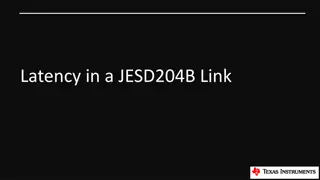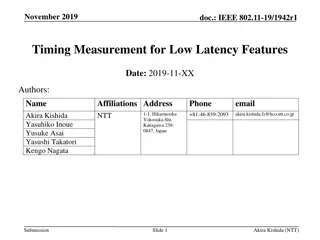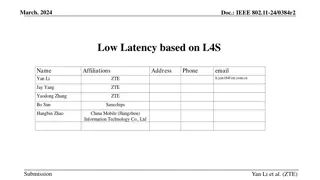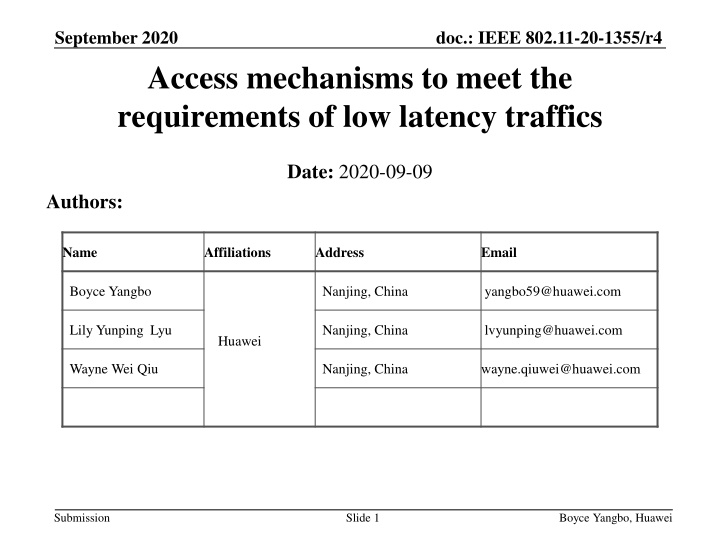
Meeting Low Latency Traffic Requirements in IEEE 802.11-20-1355/r4
Explore access mechanisms to address the needs of low latency traffic in IEEE 802.11-20-1355/r4, emphasizing the importance of latency for various services and introducing advanced strategies to reduce access delays for enhanced performance.
Download Presentation

Please find below an Image/Link to download the presentation.
The content on the website is provided AS IS for your information and personal use only. It may not be sold, licensed, or shared on other websites without obtaining consent from the author. If you encounter any issues during the download, it is possible that the publisher has removed the file from their server.
You are allowed to download the files provided on this website for personal or commercial use, subject to the condition that they are used lawfully. All files are the property of their respective owners.
The content on the website is provided AS IS for your information and personal use only. It may not be sold, licensed, or shared on other websites without obtaining consent from the author.
E N D
Presentation Transcript
doc.: IEEE 802.11-20-1355/r4 September 2020 Access mechanisms to meet the requirements of low latency traffics Date: 2020-09-09 Authors: Name Affiliations Address Email Boyce Yangbo Nanjing, China yangbo59@huawei.com Lily Yunping Lyu Nanjing, China lvyunping@huawei.com Huawei Wayne Wei Qiu Nanjing, China wayne.qiuwei@huawei.com Submission Slide 1 Boyce Yangbo, Huawei
doc.: IEEE 802.11-20-1355/r4 September 2020 Introduction Latency is critical important for some traffics. NS/EP service is agreed to be supported in 11be which requires guaranteed transmission even in worst cases[1]. Emerging services like online gaming, real-time video, industrial automation are also sensitive to latency[2] In one-hop WLAN systems, latency is mainly consist of queue delay, channel access delay, retransmission delay Queue delay is highly related to the rate gap between backhaul and WLAN air links, which can be greatly alleviated by high throughput feature in 11be. Channel access delay varies a great deal depending on channel status. New mechanisms is needed to meet the requirements of low latency traffic. Retransmission delay is also highly related to channel access delay. This contribution provides a resource reservation method offering a protected access period to improve access delay performance. Submission Slide 2 Boyce Yangbo, Huawei
doc.: IEEE 802.11-20-1355/r4 September 2020 Challenges for low latency traffic Large access delay is even worse than packet failure The transmitter can retransmit failed packet with lower MCS The transmitter has nothing to do but wait, if it is unable to get access to the channel Note: collision contributes to large access delay EDCA based mechanism has good delay performance in most cases. However, in case of heavy congestion, access delay could be very large Simulation setup Lowlatency Regular User Num n 10*n EDAC para VO BE PPDU Length 400us 4ms Retran delay 300us 300us Submission Slide 3 Boyce Yangbo, Huawei
doc.: IEEE 802.11-20-1355/r4 September 2020 Component mechanisms for low latency traffic transmission Description of low latency traffic How to differentiate low latency traffics from regular traffics (new TID, new AC) Negotiation between AP and non-AP STAs over low latency traffic characteristics and delay requirements non-AP STA make a request with uplink traffic characteristics AP make a response to indicate whether the request is accepted/modified/denied. AP announcing prioritized access mechanisms to non-AP STAs What is the prioritized access mechanism? Principles: Almost guaranteed access delay Little influence on regular traffic Little changes to STAs not supporting low latency traffic We focus on this part in following pages. Submission Slide 4 Boyce Yangbo, Huawei
doc.: IEEE 802.11-20-1355/r4 September 2020 Basic IDEAs In case of heavy congestion, AP should be able to assign some protected resources for high priority frames The protected resource is a time-frequency resource where only specified frames are allowed to transmit. Reservation of resources for some specified traffic can be announced using a new element in broadcast frames, e.g. Beacon STAs without the specified traffic shall not transmit on reserved resources Note that this restriction can be relaxed to improve efficiency which is explained in slide 8. STAs with the specified traffic are allowed to transmit on reserved resources Transmissions of any PPDU but those containing the specified traffic shall complete before the start of reserved resources. This actually creates a much less congested channel access window for critical communications. Submission Slide 5 Boyce Yangbo, Huawei
doc.: IEEE 802.11-20-1355/r4 September 2020 Illustrations and Notes Duration Offset Reserved for specified traffic TBTT TBTT EDCA based access for all traffics Interval Channel access on reserved resources could be EDCA based or other protocols. The following information is need in the new defined element RR mode (Type of traffics allowed to be sent on reserved resources), RR offset, RR interval, RR duration, RR period The resource reservation is setup and released dynamically according to link status and traffic buffer status. For an AP MLD, resource reservation can be setup on one link only Identification/notification of traffics that requires resource reservation is out of scope of this contribution: Similar topics are under discussion by many contributions[3][4][5][6] Submission Slide 6 Boyce Yangbo, Huawei
doc.: IEEE 802.11-20-1355/r4 September 2020 Application Examples Resource reservation for low latency and NS/EP traffics RR mode in yellow is set to low latency traffic RR mode in green is set to NS/EP traffic Resource reservation for AP coordinated transmission RR mode is set to AP-AP traffic AP MLD 1 Ch36 AP MLD 2 Ch149 Ch149 Ch52 AP coordinated transmission Interference to AP coordinated transmission Note: Alignment of reserved resources might be needed for multi-APs which can be easily achieved in AP coordination Submission Slide 7 Boyce Yangbo, Huawei
doc.: IEEE 802.11-20-1355/r4 September 2020 Application Examples (cont.) Resource reservation for P2P transmission Case 1 P2P transmission with high priority and latency requirement P2P transmission protected period is setup to improve P2P latency performance RR mode is set to P2P priority access Case 2 P2P transmissions cause serious collision problem to AP-STA transmission P2P transmission period is setup that P2P PPDU is allowed to be sent within this period only. RR mode is set to P2P restricted access. Note that the exact value of Resource Reservation mode is TBD Submission Slide 8 Boyce Yangbo, Huawei
doc.: IEEE 802.11-20-1355/r4 September 2020 Influence on regular traffics Efficiency of regular traffics would be degraded because the channel is even more congested The cost paid to support higher priority traffics can be reduced by dynamic setup and release. In case of heavy congestion, it s worthwhile to satisfy QoS of some traffic with minor cost. The scheduling algorithm in AP should decide whether to setup/release the resource reservation which is out of scope of 11be. Regular traffics may be allowed to be sent with a lower priority depending on the access mechanism adopted on reserved resources. For example EDCA based access mechanism: regular traffics can access channel with a low- priority set of EDCA parameters(e.g. a large AIFSN and CWmin) Trigger based access mechanism: regular traffics are scheduled by AP only if there is no low latency traffics to be sent. Submission Slide 9 Boyce Yangbo, Huawei
doc.: IEEE 802.11-20-1355/r4 September 2020 Coexistence with Pre-EHT STAs In an actual WLAN network, both EHT and pre-EHT STAs may exist. It s not fair and not helpful to mute EHT STAs only. Quiet element can be used with a new defined resource reservation element when both EHT and pre-EHT STAs need to be muted. Multiple Quiet elements can setup/release reserved resources as shown in previous pages Resource reservation element is used to notify EHT STA which traffic is allowed to transmit Pre-EHT STAs are muted by Quiet elements EHT STAs without the traffic specified in RR element are also muted EHT STAs with the traffic specified in RR element can access channel to transmit Resource reservation element should have a short variant when used together with quiet elements STAs can obtain the information(like resource reservation period, offset, interval, duration) from quiet elements. It would be redundant to include those information in resource reservation element. Submission Slide 10 Boyce Yangbo, Huawei
doc.: IEEE 802.11-20-1355/r4 September 2020 Support of Non-periodic Burst Traffic Recall the low latency traffics defined in[2], 7 use cases with different traffic models are discussed. Many of them have non-periodic low latency traffics. Extendable duration of reserved resource could be included to balance between efficiency and burst traffic QoS. extended duration for burst traffic regular duration TBTT TBTT Regular resource reservation variant carried in Beacon frame temp resource reservation variant carried in action frame Regular duration could be setup according to the statistic characters of non-periodic traffic, for example average amount of traffic, 2 sigma amount of traffic, etc. Extended duration is setup by a temp resource reservation variant carried in an action frame sent by AP according to amount of burst traffics and unexpected interference. Submission Slide 11 Boyce Yangbo, Huawei
doc.: IEEE 802.11-20-1355/r4 September 2020 Influence on standard work Resource reservation mechanism is a very simple and effective design which is consistent with previous version of standard. Quiet element has already been introduced in existing standard. What the group need to do is to introduce a new element. What the STA need to do is quite similar to existing Quiet procedures (when to mute, how long to mute for, mute period and interval). The only thing new to EHT STA is to recognize which type of traffic is allowed to unmute. Again, we want to point out that this resource reservation mechanism does not restrict how to use reserved resources, for example An easy way: we use existing EDCAF or trigger-based access mechanism on reserved resources, no extra efforts needed. An elaborate way: we introduce a new access mechanism for better access performance. Note that, this mechanism actually provides mutual protection It protects low latency traffic from congestion of regular traffics It protects regular STAs from additional complexity by any new defined access mechanism applied on reserved resources Submission Slide 12 Boyce Yangbo, Huawei
doc.: IEEE 802.11-20-1355/r4 September 2020 Summary A resource reservation mechanism is proposed to improve delay performance in heavy congestion cases. A very brief summary of our idea is that we add an exception in quiet procedure by adding a new defined element. Benefits The standard work related to this mechanism is very simple and it adds no complexity to regular STAs. Any access mechanism is supported on reserved resources with almost no influence on regular STAs Latency performance would not be degraded with the existence of pre-EHT STAs The mechanism can further differentiate priorities of multiple low-latency traffics with different delay requirements. Influence on regular traffics can be reduced by dynamic setup and release Submission Slide 13 Boyce Yangbo, Huawei
doc.: IEEE 802.11-20-1355/r4 September 2020 Straw Poll 1 Do you agree that 11be introduces a restricted access mechanism as follows: For non-AP STAs supporting this mechanism, specified traffics have higher priority to transmit on reserved resources. Note: Traffics given higher priority to transmit are specified in TBD procedures. The restricted access mechanism can be set up and released dynamically. The restricted access mechanism is intended to improve delay performance of low latency traffics in case of heavy congestion Submission Slide 14 Boyce Yangbo, Huawei
doc.: IEEE 802.11-20-1355/r4 September 2020 Straw Poll 2 Do you agree that 11be introduces a resource reservation element including the following information. Traffic identifier offset Duration interval period Note: resource reservation element is used to announce the reserved resources to non-AP STAs The description/identification of low latency traffics is TBD. Other information in resource reservation element is TBD Submission Slide 15 Boyce Yangbo, Huawei
doc.: IEEE 802.11-20-1355/r4 September 2020 References [1] 11-20-0566-59-00be-compendium-of-straw-polls-and-potential-changes-to-the- specification-framework-document [2] 11-18-2009-06-0rta-rta-report-draft [3] 11-20-0418-03-00be-low-latency-service-in-802-11be [4] 11-20-1006-01-00be-new-methods-to-meet-low-latency-requirements [5] 11-20-1067-00-00be-traffic-indication-of-latency-sensitive-application [6] 11-20-1041-02-00be-edca-queue-for-rta Submission Slide 16 Boyce Yangbo, Huawei
doc.: IEEE 802.11-20-1355/r4 September 2020 Backup Submission Slide 17 Boyce Yangbo, Huawei
doc.: IEEE 802.11-20-1355/r4 September 2020 Definition of Delays in slide 2 Buffer Delay (MSDU based) Buffer delay is measured from the time the MSDU is passed to MAC until the point at which the corresponding MPDU/trigger starts EDCA access (i.e. set backoff counter). Buffer delay consist of the time in DDR waiting for scheduling, scheduling time, the time waiting in AC queue Channel access delay(MPDU based) Channel access delay is measured from the time the EDCAF begins CSMA/CA access until the actual frame transmission start time. Retransmission delay(MPDU based) Retransmission delay depends on the scheduling algorithm in AP Retransmission delay is approximately the sum of retransmission scheduling delay and channel access delay Submission Slide 18 Boyce Yangbo, Huawei
doc.: IEEE 802.11-20-1355/r4 September 2020 Discussion on Low latency features in 11be The standard (i.e. 11be) can not provide any guaranteed QoS of Low latency traffic but a supportive mechanism. The implementation specific algorithms are responsible for the QoS performance which seems to be extremely difficult by current channel access mechanism under heavy congested situations Guaranteed access delay is not a deterministic delay but a high probabilistic delay. The numerical delay bound guaranteed by an AP is a implementation related parameter, which depends on the scheduling algorithms adopted. For example, an AP may provide access delay up bound 10ms with 90% and 50ms with 99.9% Note that: the description is related to reliability as well. Since reliability is also related to MCS selection, ARQ, TX power adaptation, etc, we should focus on delay of a single access. Submission Slide 19 Boyce Yangbo, Huawei
doc.: IEEE 802.11-20-1355/r4 September 2020 Data cursor for simulations results of access latency under EDCA 10%ile (ms) 1%ile (ms) 0.1%ile (ms) 1-10 12.56 25.41 41.64 2-20 14.54 31.85 50.58 3-30 17.29 30.04 56.55 4-40 20.59 43.26 66.56 5-50 26.57 54.93 84.07 6-60 34.7 70.68 106.5 7-70 44.9 91.39 136.3 8-80 58.45 117.4 176.1 Note that: access delay shown here only count low latency traffic. 9-90 74.96 151.1 226.5 Submission Slide 20 Boyce Yangbo, Huawei
doc.: IEEE 802.11-20-1355/r4 September 2020 Discussion of protected access period Protected access period for specified STA or specified Traffic? QoS mechanisms should be designed based on traffics not devices If a STA has more than one type of traffic, it s not right to let a low priority traffic (e.g. downloading) have same QoS as high priority traffic (e.g. online game) Very limited types of traffics vs variable number of STAs A STA has at least one type of traffic, so the number of types is smaller than that of STAs. The notification procedure would be simpler and less cost. For STAs having more than one priority access traffics (different delay requirements), it is very difficult to use device based resource reservation to handle this. For example, a STA has 2 traffics whose access delay requirements are 20ms and 100ms respectively. Both traffics need 1ms to transmit The STA needs 2 different protected access periods which is actually traffic based. For non-periodic traffics, statistic multiplexing can be used for traffic based resource reservation to improve channel efficiency. Periodic resource reservation can be setup based on concurrency rate of the specified traffic over all STAs Submission Slide 21 Boyce Yangbo, Huawei
doc.: IEEE 802.11-20-1355/r4 September 2020 Influence on other links in case of ML Protected access periods can be setup on one of the links (link 1) when latency performance is bad. For STR AP MLD: If non-AP STAs are STR MLDs Transmissions on other links would not be affected If non-AP STAs are NSTR/SR-MLDs For regular STAs, transmissions on other links are not affected For low latency STAs, transmissions on other links need to stop before the start of protected period as well If non-AP STAs don t have ML ability. Transmissions on other links would not be affected. Submission Slide 22 Boyce Yangbo, Huawei
doc.: IEEE 802.11-20-1355/r4 September 2020 Alignment of reserved resources for M-AP Hidden node problem would be very serious in case of AP-AP communication. Resource reservation can be used to mute STAs during AP-AP transmission. In this case, the reserved resources need to be aligned between 2 or more BSS. The TBTTs of multiple AP can be set as follows to avoid Beacon collisions. Beacon Reserved Resources AP1 Option 1 AP2 AP1 Option 2 AP2 Note that: the exact strategy adopted by AP is implementation dependent. Submission Slide 23 Boyce Yangbo, Huawei
doc.: IEEE 802.11-20-1355/r4 September 2020 Quiet element for resource reservation Duration Offset TBTT Period (=1) Multiple Quiet elements and one short resource reservation element can setup multiple reserved resources as follows Note that: For scenarios with no pre-EHT STAs, one resource reservation element can setup multiple reserved resources as well. Submission Slide 24 Boyce Yangbo, Huawei
doc.: IEEE 802.11-20-1355/r4 September 2020 Example design of resource reservation element As described above, we need several variant of resource reservation elements: regular setup, short setup, temp setup, temp release and regular release. Element ID Extension Element ID Length Control Resource Reservation Info Control 0 Regular Resource Reservation setup 1 Short Regular Resource Reservation setup 2 Temp Resource Reservation setup 3 Temp Resource Reservation release 4 Regular Resource Reservation release Other values are reserved Submission Slide 25 Boyce Yangbo, Huawei
doc.: IEEE 802.11-20-1355/r4 September 2020 Example design of resource reservation element (2) We also need to include the following information in the resource reservation element: Resource Reservation offset, Resource Reservation interval, Resource Reservation duration, Resource Reservation period, Resource Reservation mode (Type of traffics allowed to be sent). Element ID Extension Element ID Length Control Resource Reservation Info Resource Reservation Offset Resource Reservation Interval Resource Reservation Duration Resource Reservation Period Resource Reservation Mode Regular Resource Reservation Setup variant Submission Slide 26 Boyce Yangbo, Huawei
doc.: IEEE 802.11-20-1355/r4 September 2020 Example Values of Resource Reservation Mode The values of resource reservation mode is highly related to the description of priority access traffics, we just give some example here. By different values in RR mode field, the protected access mechanism is very flexible to support many different types of traffic and their combinations Value Description Notes 0 DFS Channel sensing No traffic allowed 1 Low latency traffic type 1 Delay Requirement: <10ms 2 Low latency traffic type 2 Delay Requirement: <20ms 3 Low latency traffic type 3 Delay Requirement: <50ms 4 NS/EP traffic 5 AP-AP traffic 6 P2P critical traffic Only critical P2P transmission is allowed 7 P2P restricted traffic P2P transmission is not allowed at any other time 8 Unspecified low latency frame Frames with higher priority, e.g. Control frames 9 Vendor specific traffic 10~255 To be discussed Note that exact values of resource reservation mode are TBD Submission Slide 27 Boyce Yangbo, Huawei


